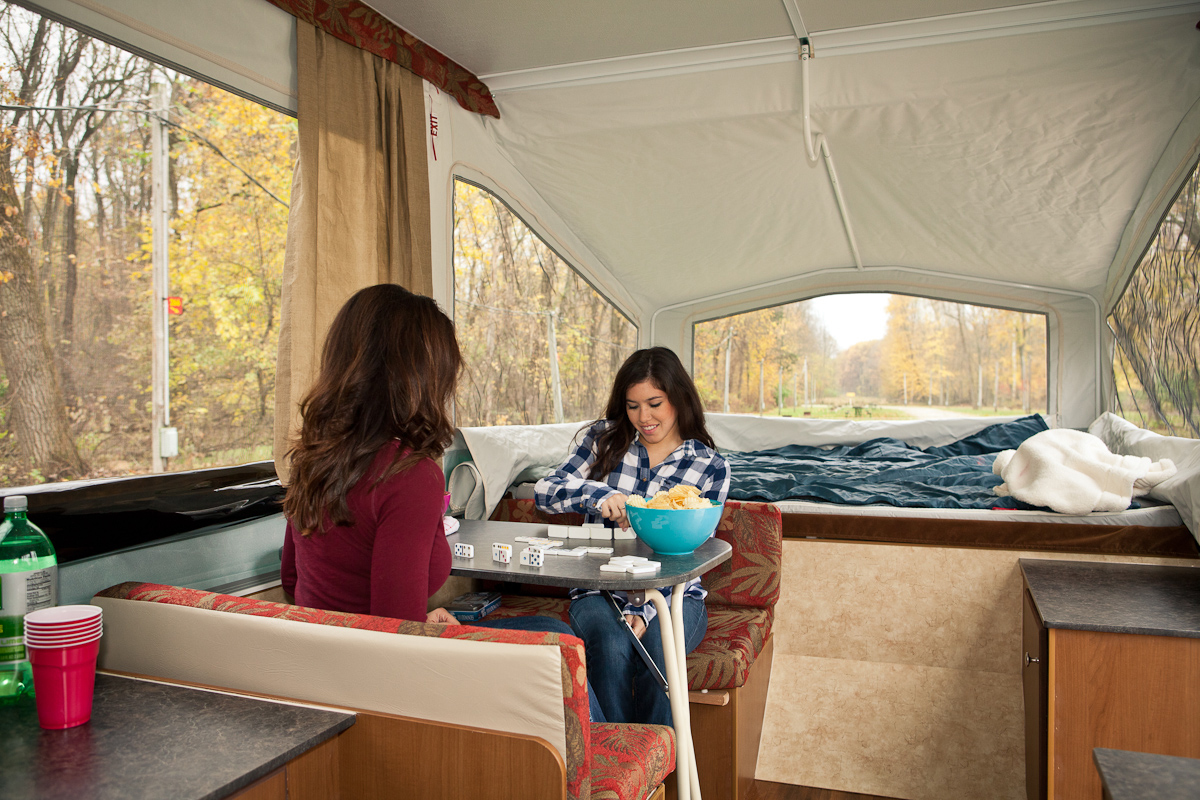A folding camping trailer, also commonly known as a pop up or pop up camper, is a popular choice for individuals and families who like the combination soft side/hard side construction, the ability to trailer a low-profile RV on the road, compact functionality, affordability, and space for up to eight people.
Should I store my pop up expanded or closed?
Leaving your camper “up” might seem like a good idea. However, since pop ups are constructed with soft sides, typically canvas, leaving it popped up is an invitation for critters and pests to enter and set up house or cause destruction. As with any RV, everything needs to be cleaned and put away properly so that the RV is all set to go the next time it’s time to go camping. This includes making sure all the canvas is well-dried before collapsing the sides and roof – you don’t want mildew. Also, it may seem tempting, but don’t put an airtight cover over the top of the camper. Choose a fabric that will allow air flow but still help keep off dust and dirt from the roof of the pop up.
Best exterior cleaning products?
Fiberglass and canvas develop stains from bugs and leaves and dirt over time. RVers have found that Simple Green, bleach, and Clorox bathroom cleaner tend to work well on canvas areas… along with some elbow grease. Fiberglass tops should be treated with specific fiberglass stain remover that can be found at boat supply stores. Always rinse the RV off thoroughly after using any cleaning product. According to an RV forum, one savvy RVer recommends cleaning and rinsing in the shade so that any product used can sit and do its work and not dry out too quickly.
Does a pop up have a bathroom?
Many folding camping trailers do not have a bathroom, but you can find models that do. Pop up camper have a lot of perks and space by utilizing slide-outs, such as a kitchen, heat, air conditioning, sleeping areas, and living space.
Can you heat or cool off the interior of a pop up?
Yes, many pop ups come equipped with heating and air-conditioning functionality. Keep the windows zipped up for optimal utilization of these functions.
What happens when it rains?
Since a pop up is a soft-sided RV, the canvas will get wet and will need to dry out. You can put a tarp or awning over the top to help keep the rain from hitting the camper directly. Be careful of high winds that can send branches down from surrounding trees as they can create tears in the canvas sides. Most roofs are made of hard material for extra protection from the elements. But all things considered, pop ups can handle rainy days just like a tent – and can be a blessing for busy families because it causes them to slow down.
Can I camp with a pop up in the winter?
Yes, you can with a few preparations. Temperature is the biggest concern, both for yourself and for the camper. Make sure you have thick blankets and mattress pads and refrain from using the door too frequently if a heater is turned on. Cover your propane tanks and any water lines to keep them insulated and protected from freezing. It’s important to leave a vent cracked to avoid condensation inside the trailer as well. You may want to purchase a pop up gizmo, a cover that provides extra insulation. Also, if you’ll be camping for some time and experience snowfall, remove the snow from the roof or overlaying tarp as it can get too heavy and cause its own problems.
Is a pop up difficult to set up?
Many campers find it simple to set up their folding camping trailer single-handedly. Set-up is generally easier with at least two people working together, however, especially when it comes to leveling the camper. Pop ups have built-in cranks and slide-outs that are typically easy to maneuver so that a pop up goes up in a jiffy. The parts of setups that are best done by two people are backing into the campsite and leveling the camper on the site.
Can you set up a pop up at night?
Yes, but again, it’s a good idea to do this with at least one other person who can act as a guide and spotter. You don’t want to run into a tree or sink a wheel into a fire pit. The biggest thing about setting up at night is being as quiet as possible in consideration for your neighboring campers. Sound travels far and loud in the nighttime hours. A head lamp comes in handy as well as high-beam flashlights or lanterns that can be held by others or placed on a table. If you’ve never camped with a pop up camper before, practice backing in and setting up at home before your camping weekend. When you reach the campsite, turn the headlights off as soon as possible, or turn the tow vehicle around to give you extra light to finish unhooking and leveling the pop up. Alternatively, you can alter your plans so that you reach the campground as early as possible the next morning. Another way to back into the site is to unhitch the camper and push it into the site (if you have a tongue wheel and usually with more than one person).

